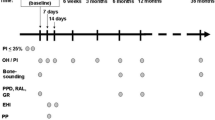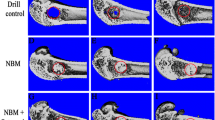Abstract
We investigated the architecture of periodontal ligament regenerated by an enamel matrix derivative (EMD, Emdogain®) coating on the surface of hydroxyapatite (EMD-HA). Immediately after extraction of the maxillary first molar in rats, HA alone or EMD-HA was implanted into the socket. At 5 days, and 2 and 4 weeks after implantation, the specimens were examined by light and transmission electron microscopy, and immunohistochemistry for periostin and matrix metalloproteinase (MMP)-13. Histological observations revealed a large number of fibroblasts and well-developed blood capillaries in the fibrous connective tissue surrounding EMD-HA at 5 days. Ultrastructural analysis showed a distinct difference in the architecture of the fibrous connective tissue. As compared with the poorly constructed architecture of HA, EMD-HA had an orderly alignment of fibroblasts and bundled collagen fibers, with some fibroblasts in the cytoplasm showing collagen fiber phagocytosis. Periostin immunoreactivity was observed in the fibrous connective tissue around EMD-HA at each time point, but was not seen in HA at 5 days and 2 weeks. MMP-13 immunoreactivity was intensely localized in fibroblasts at 5 days and 2 weeks in EMD-HA. The present results indicate that EMD may greatly contribute to a well-developed architecture accompanied by orderly alignment of fibroblasts and bundled collagen fibers, through accelerated induction of periostin, maintenance of fibrillogenesis, and degradation of collagen fibers by extracellular proteinase and phagocytosis.




Similar content being viewed by others
References
Donos N, Sculean A, Glavind L, Reich E, Karring T (2003) Wound healing of degree III furcation involvements following guided tissue regeneration and/or Emdogain®. A histologic study. J Clin Periodontol 30:1061–1068
Freije JMP, Díaz-Itza I, Balbín M, Sánchez LM, Blasco R, Tolivia J, López-Otín C (1994) Molecular cloning and expression of collagenase-3, a novel human matrix metalloproteinase produced by breast carcinomas. J Biol Chem 269:16766–16773
Gestrelius S, Andersson C, Lidström D, Hammarström L, Somerman M (1997) In vitro studies on periodontal ligament cells and enamel matrix derivative. J Clin Periodontol 24:685–692
Giannobile WV, Somerman MJ (2003) Growth and amelogenin-like factors in periodontal wound healing. A systemic review. Ann Periodontol 8:193–204
Hamamoto Y, Kawasaki Y, Jarnbring F, Hammarström L (2002) Effects and distribution of the enamel matrix derivative Emdogain® in the periodontal tissues of rat molars transplanted to the abdominal wall. Dent Traumatol 18:12–23
Hammarström L (1997a) Enamel matrix, cementum development and regeneration. J Clin Periodontol 24:658–668
Hammarström L (1997b) The role of enamel matrix proteins in the development of cementum and periodontal tissues. In: Chanwick DJ, Cardew G (eds) Dental enamel (Ciba Foundation Symposium). Wiley, New York, pp 246–260
Heden G, Wennström JL (2006) Five-year follow-up of regenerative periodontal therapy with enamel matrix derivative at sites with angular bone defects. J Periodontol 77:295–301
Heijl L (1998) Periodontal regenerative potential using enamel matrix proteins (EMDOGAIN®). Tandläkartidningen 90:53–62
Horiuchi K, Amizuka N, Takeshita S et al (1999) Identification and characterization of a novel protein, priostin, with restricted expression to periosteum and periodontal ligament and increased expression by transforming growth factor β. J Bone Miner Res 14:1239–1249
Kii I, Amizuka N, Minqi L, Kitajima S, Saga Y, Kudo A (2006) Periostin is an extracellular matrix protein required for eruption of incisor in mice. Biochem Biophys Res Commun 342:766–772
Koike Y, Murakami S, Matsuzaka K, Inoue T (2005) The effect of Emdogein® on ectopic bone formation in tubes of rat demineralized dentin matrix. J Periodont Res 36:385–394
Laaksonen M, Sorsa T, Salo T (2010) Emdogain® in carcinogenesis: a systematic review of in vitro studies. J Oral Sci 52:1–11
Leonardi R, Talic NF, Loreto C (2007) MMP-13 (collagenase 3) immunolocalisation during initial orthodontic tooth movement in rats. Acta Anat 109:215–220
Lyngstadaas SP, Lundberg E, Ekdahl H, Andersson C, Gestrelius S (2001) Autocrine growth factors in human periodontal ligament cells cultured on enamel matrix derivative. J Clin Periodontol 28:181–188
Margadant C, Sonnenberg A (2010) Integrin-TGF-β crosstalk in fibrosis, cancer and wound healing. EMBO Rep 11:97–105
Norris RA, Damon B, Mironov V et al (2007) Periostin regulates collagen fibrillogenesis and the biomechanical properties of connective tissues. J Cell Biochem 101:695–711
Okubo K, Kobayashi M, Takiguchi T, Takada T, Ohazama A, Okamatsu Y, Hasegawa K (2003) Participation of endogenous IGF-I and TGF-β1 with enamel matrix derivative-stimulated cell growth in human periodontal ligament cells. J Periodont Res 38:1–9
Padial-Molina M, Volk SL, Taut AD, Giannobile WV, Rios HF (2012) Periostin is down-regulated during periodontal inflammation. J Dent Res 91:1078–1084
Padial-Molina M, Volk SL, Rodrigues JC, Marchesan JT, Galindo-Moreno P, Rios HF (2013) Tumor necrosis factor-α and porphyromonas gingivalis lipopolysaccharides decrease periostin in human periodontal ligament fibroblasts. J Periodontol 84:694–703
Parkar MH, Tonetti M (2004) Gene expression profiles of periodontal ligament cells treated with enamel matrix proteins in vitro: analysis using cDNA arrays. J Periodontol 75:1539–1546
Shimazaki M, Nakamura K, Kii I et al (2008) Periostin is essential for cardiac healing after acute myocardial infarction. J Exp Med 205:295–303
Suzuki H, Amizuka N, Kii I et al (2004) Immunohistochemical localization of periostin in tooth and its surrounding tissues in mouse mandibles during development. Anat Rec Part A 281A:1264–1275
Svoboda ELA, Shiga A, Deporter DA (1981) A stereologic analysis of collagen phagocytosis by fibroblasts in three soft connective tissues with differing rates of collagen turnover. Anat Rec 199:473–480
Takahashi I, Nishimura M, Onodera K et al (2003) Expression of MMP-8 and MMP-13 genes in the periodontal ligament during tooth movement in rats. J Dent Res 82:646–651
Takahashi I, Onodera K, Nishimura M, Mitani H, Sasano Y, Mitani H (2006) Expression of genes for gelatinases and tissue inhibitors of metalloproteinases in periodontal tissues during orthodontic tooth movement. J Mol Hist 37:333–342
Van der Pauw MT, Van den Bos T, Everts V, Beertsen W (2000) Enamel matrix-derived protein stimulates attachment of periodontal ligament fibroblasts and Enhances alkaline phosphatase activity and transforming growth factor β1 release of periodontal ligament and gingival fibroblasts. J Periodontol 71:31–43
Wennström JL, Lindhe J (2002) Some effects of enamel matrix proteins on wound healing in the dento-gingival region. J Clin Periodontol 29:9–14
Yajima T, Rose GG (1977) Phagocytosis of collage by human gingival fibroblasts in vitro. J Dent Res 56:1271–1277
Yajima T, Matsuo A, Hirai T (1989) Collagen phagocytosis by cementoblasts at the periodontal ligament-cementum interface. Arch Histol Cytol 52:521–528
Acknowledgements
We express our appreciation to Dr. H. Inoue, Shiga University of Medical Science, for the kind gift of anti-periostin antibody.
Author information
Authors and Affiliations
Corresponding author
Ethics declarations
Conflict of interest
The authors declare that they have no conflict of interest.
Additional information
Publisher's Note
Springer Nature remains neutral with regard to jurisdictional claims in published maps and institutional affiliations.
Rights and permissions
About this article
Cite this article
Shibui, T., Yajima, T., Irie, K. et al. Architecture of connective tissue regenerated by enamel matrix derivative around hydroxyapatite implanted into tooth extraction sockets in the rat maxilla. Anat Sci Int 95, 334–341 (2020). https://doi.org/10.1007/s12565-020-00526-2
Received:
Accepted:
Published:
Issue Date:
DOI: https://doi.org/10.1007/s12565-020-00526-2




